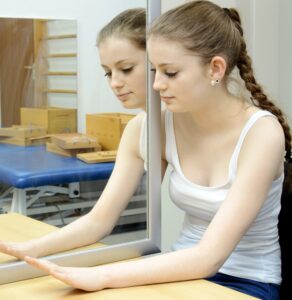Mirror therapy
Last edited: 20/12/2022
What is mirror therapy and who is it for?
It is a non-invasive treatment technique for people with persistent pain. It has shown to be effective as part of the treatment programme of people suffering from Phantom Limb Pain (PLP), Complex Regional Pain Syndrome (CRPS) and following a stroke.
How does it work?
The ultimate goal of mirror therapy is to correct misrepresentations in the brain’s body map which develop when an injury or loss of limb occurs. In fact, this is what is thought to cause phantom pain associated with losing an arm, leg or other body part, particularly if the part was affected by pain before removal.
The theory is the brain records or remembers the pain in a specific area and continues to send out nerve signals, fully expecting to receive some back. In other words, in the absence of experiencing true physical sensations in the area, the brain resorts to filling in the blanks, based on the misperception the missing body part is still intact.
The primary tool for this treatment is a mirror box, from which the patient receives visual feedback in order to train the brain to configure a new ‘body map’. This ‘map’ is simply the hard-wired mental representation which allows a person to be aware of where each component of the body is at all times, even in complete darkness.
Will mirror therapy get rid of pain?
Unfortunately, there is little hard evidence from large scale research studies about the absolute effectiveness of this technique. Case studies and anecdotal data have shown mirror therapy can indeed help to relieve the symptoms of PLP and CRPS, while encouraging rehabilitation after suffering a stroke. A complete cure is, nevertheless, unlikely.
Guidelines for mirror therapy
 Find a quiet space where you will not be distracted or interrupted.
Find a quiet space where you will not be distracted or interrupted.- Position the mirror so the reflective surface is facing your unaffected limb and the affected limb – the painful or sensitive one – is hidden behind the mirror.
- Four to five, 10-minute sessions each day are required to achieve progress, however, don’t expect to be able to tolerate this length of time immediately. You might need to start with as little as 30 seconds before being able to build up your tolerance to the technique very gradually.
- Start by observing the mirror image of your unaffected limb and simply look at this reflection without moving.
- Concentrate hard on the mirror reflection for a couple of minutes.
- Very slowly start to move both limbs in exactly the same way while looking at the reflection in the mirror.
Reproduced with permission from McCabe C.S. (2011). Mirror Visual Feedback Therapy. A Practical Approach. Journal of Hand Therapy 24(2): 170-179.
Are there any side effects?
No specific side effects have been reported by using this technique. Some symptoms you might expect to experience during treatment include the hidden limb feeling heavier or lighter, warmer or colder, reduced sensation or a ‘floating’ feeling.
You might initially experience a slight flare-up of your symptoms. If that is the case, cut down on the time you spend practicing the technique each time.
If pain prevents movement of your affected limb, try to imagine you are moving it in the same manner as the unaffected side.
If pain or other symptoms become a problem while you are exercising, stop and go back to simply looking at the mirror image with both limbs resting.
Contact us
0300 123 1753
Monday to Friday, 9am to 5pm
This information should only be followed on the advice of a healthcare professional.
Do you have feedback about our health services?
0800 030 4550
Text 07899 903499
Monday to Friday, 8.30am to 4.30pm
kentchft.PALS@nhs.net
kentcht.nhs.uk/PALS
Patient Advice and Liaison Service (PALS)
Kent Community Health NHS Foundation Trust
Trinity House, 110-120 Upper Pemberton
Ashford
Kent
TN25 4AZ
![]()
Donate today, and help the NHS go above and beyond. Visit kentcht.nhs.uk/icare
If you need communication support or this information in another format, please ask a member of staff or contact us using the details above.
